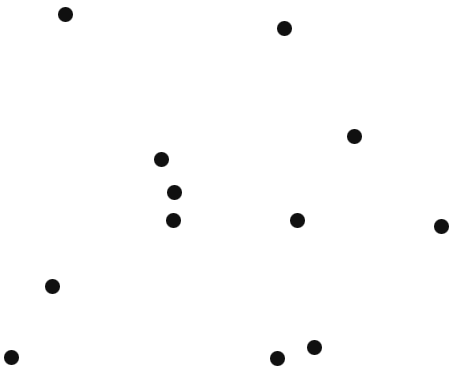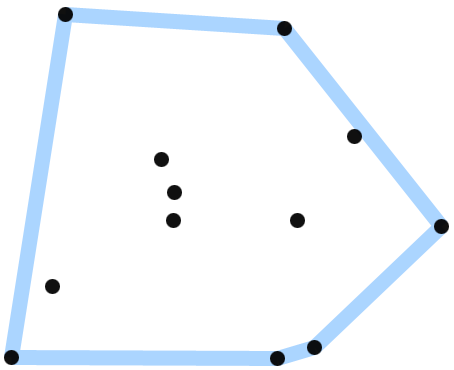// public-domain code by Darel Rex Finley, January 2009
#define CIRCLE_RADIANS 6.283185307179586476925286766559
// Determines the radian angle of the specified point (as it relates to the origin).
//
// Warning: Do not pass zero in both parameters, as this will cause division-by-zero.
double angleOf(double x, double y) {
double dist=sqrt(x*x+y*y) ;
if (y>=0.) return acos( x/dist) ;
else return acos(-x/dist)+.5*CIRCLE_RADIANS; }
// Pass in a set of 2D points in x,y,points. Returns a polygon in polyX,polyY,polyCorners.
//
// To be safe, polyX and polyY should have enough space to store all the points passed in x,y,points.
void findSmallestPolygon(double *x, double *y, long points, double *polyX, double *polyY, long *polyCorners) {
double newX=x[0], newY=y[0], xDif, yDif, oldAngle=.5*CIRCLE_RADIANS, newAngle, angleDif, minAngleDif ;
long i ;
// Find a starting point.
for (i=0; i<points; i++) if (y[i]>newY || y[i]==newY && x[i]<newX) {
newX=x[i]; newY=y[i]; }
*polyCorners=0;
// Polygon-construction loop.
while (!(*polyCorners) || newX!=polyX[0] || newY!=polyY[0]) {
polyX[*polyCorners]=newX;
polyY[*polyCorners]=newY; minAngleDif=CIRCLE_RADIANS;
for (i=0; i<points; i++) {
xDif=x[i]-polyX[*polyCorners];
yDif=y[i]-polyY[*polyCorners];
if (xDif || yDif) {
newAngle=angleOf(xDif,yDif); angleDif =oldAngle-newAngle;
while (angleDif< 0. ) angleDif+=CIRCLE_RADIANS;
while (angleDif>=CIRCLE_RADIANS) angleDif-=CIRCLE_RADIANS;
if (angleDif<minAngleDif) {
minAngleDif=angleDif; newX=x[i]; newY=y[i]; }}}
(*polyCorners)++; oldAngle+=.5*CIRCLE_RADIANS-minAngleDif; }}
|


